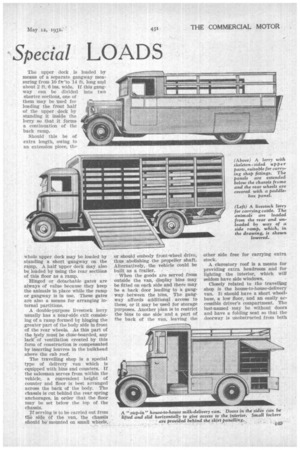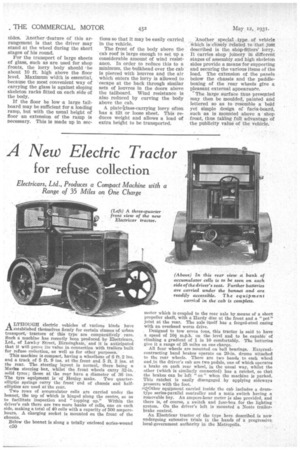Special BODIES for Special LOADS
Page 118

Page 119

Page 120

If you've noticed an error in this article please click here to report it so we can fix it.
In this Article Our Bodybuilding Expert Deals with Livestock Lorries, Mobile Shops, Vehicles for Transporting Sheet Glass and Motors to Meet the Require ments of the Joiner
ANOTABLE feature of the livestock lorry is that it may be used for more than one purpose. There is a large demand for a double-deck vehicle which is suitable for carrying sheep or pigs, whilst by means of a folding or removable upper floor the lorry may also be utilized for the conveyance of cattle, or other large animals. Such a conversion may be partial or
complete. '
In order that a single-decker may he converted into a double-decker, the upper floor is frequently divided in halves both lengthwise and crosswise. Thelranaverse division of floor allows the front part of the vehicle to be used as a doubledecker and the rear as a singledecker.
As the upper floor is in four sections it is,easy to handle, but if the sections be hinged at the sides the headroom above one floor must he at least half as much as the inside width of the lorry.
Loading at the normal floor level is effected by means of the usual rear ramp, which also forms the hack of the vehicle. If the floor be high, such as when there are no wheel-arches, the ramp may have an extension piece.
The upper deck is loaded by means of a separate gangway measuring from 10 ftt'to 14 ft. long and about 2 ft, 8 ins. wide. If this gangway can be divided into two shorter sections, one of them may be used for loading the front half of the upper deck by standing it inside the lorry so that it forms a continuation of the back ramp.
Should this be of extra length, owing to an extension piece, the whole upper deck may be loaded by standing a short gangway on the ramp. A half upper deck May also be. loaded by using the rear sectiOns of this floor as a ramp.
Hinged or detachable gates are always of value because they keep the animals in place while the ramp or gangway is in use. These gates are also a means for arranging internal partitions.
A double-purpose livestock lorry usually has a near-side exit consisting of a ramp formed by hinging the greater part of the body side in front of the rear wheels. As this part of the body must be close-boarded, any lack' of ventilation created by this form of construction is compensated by inserting louvres in the bulkhead above the cab roof.
The travelling shop is a special type of delivery van which is equipped with bins and counters. If the salesman serves from within the vehicle, a convenient height of counter and floor is best arranged across the back of the body. The chassis is cut behind the rear spring anchorages, in order that the floor may be set below the top of the If serving is to be carried out from the side Of the van, the chassis should be mounted on small wheels, or should embody front-wheel drive, thus abolishing the propeller shaft. Alternatively, the vehicle could be built as a trailer.
When the goods are served from outside the van, display bins may be fitted on each side and there may be a back door leading to a gangway between the bins. The gangway affords additional access to these, or it may be used for storage purposes. Another plan is to restrict the bins to one side and a part of the back of the van, leaving the
other side free for carrying extra stock.
A .clerestory roof is a means for providing extra headroom and for lighting the interior, which will seldom have side windows.
Closely related to the travelling shop is the house-to-house-delivery van. It should have a short wheelbase, a low floor, and an easily accessible driver's compartment. The last-named may be without doors and have a folding seat so that the doorway is unobstructed from both sides. Another feature of this arrangement is that the driver may stand at the wheel during the short stages of his round.
For the transport of large sheets of glass, such as are used for shop fronts, the lorry body should 'be about 10 ft. high above the floor level. Maximum width is essential, because the most convenient way of carrying the glass is against sloping skeleton racks fitted on each side of the body.
If the floor be low a large tailboard may be sufficient for a loading ramp, but with the usual height of floor an extension of the ramp is necessary. This is made up in sec
tions so that it may be easily carried in the vehicle.
The front of the body above the cab roof is large enough to set up a considerable amount of wind resistance. In order to reduce this to a minimum, the bulkhead over the cab is pierced with louvres and the air which enters the lorry is allowed to escape at the back through similar sets of louvres in the doors above the tailboard. Wind resistance is also reduced by curving the body above the cab.
A. plate-glass-carrying lorry often has a tilt or loose sheet. This reduces weight and allows a load of extra height to be transported.
Another special type of vehicle Which is closely related to that just described is the shop-fitters' lorry. It carries shop joinery in different stages of assembly and high skeleton sides provide a means for supporting and securing the various items of the load. The extension of the panels below the chassis and the paddleboxing of the rear wheels give a pleasant external appearance.
The large surface thus prese,nted may then be moulded, painted and lettered so as to resemble a bold yet simple design of facia-board, such as is mounted above a shop front, thus taking full advantage of the publicity value of the vehicle.




































































































































































































